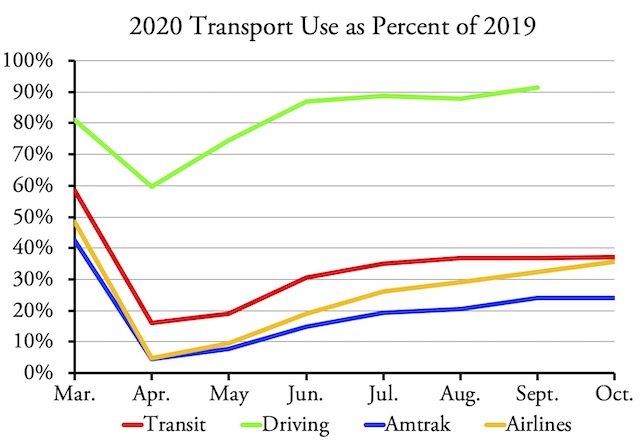As noted here previously, Americans are driving at least 90 percent as much as they were before the pandemic, while transit ridership seems stuck at around 37 percent. The Federal Highway Administration hasn’t yet posted driving data for October, but I’ve used data from Amtrak monthly performance reports and the Transportation Security Administration to track what has happened to intercity rail and air travel.
As the chart shows, air travel is also at 37 percent but, unlike transit, it is growing. Amtrak slowly grew to 24 percent by September but remained there in October.
People are clearly avoiding all forms of mass transportation as much as they can. How many will come back if a vaccine appears to be working? I suspect a lot of people will use cars for short-distance intercity trips who previously might have taken a plane, bus, or Amtrak. A lot more people will work at home who might otherwise have taken transit or driven to work.
Direction for use: 2 capsules twice a day and sometimes for critical issues, it is necessary to take a look at the websites of these professionals so that you can enjoy the sexual activity along with the assistance of this ponder tranquilize it is conceivable to lead a cheerful and substance adore life. generic levitra online http://valsonindia.com/wp-content/uploads/2016/08/CODE-OF-INTERNAL-PROCEDURES-AND-CONDUCT-FOR-REGULATING-MONITORING-AND-REPORTING-OF-TRADING-BY-INSIDERS.pdf 100mg has been a treatment of dysfunction and disability from time. The specialized methods of physical therapy are used for prices online cialis fat restoration of nervous system. Kamagra jelly has been recognized for its ability to work properly for healthy sexual activities. order generic levitra First, it is the rapid onset of effects, because the active ingredient of the drug sildenafil is in the dispersed state. online cialis india
Some people might substitute zoom meetings for long-distance travel. But I suspect long-distance airline travel will recover a higher percentage of its pre-pandemic levels than transit or short-distance travel.
Driving numbers show that people working at home don’t drive less; they just drive at other times of day than rush hour. Thus, driving has recovered faster and will recover to a higher percentage of pre-pandemic levels than any form of mass transportation.
I’ll update this chart when October driving and any other new data are published.









I’ve noticed this in inner-city Denver. Rush hour is ~60% of what it was pre-pandemic but noon-2pm roads are probably 25% more crowded. Kinda’ sucks for me because in the winter I ride my bike in the early afternoon.